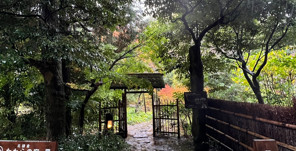起雲閣(きうんかく)
観光・その他
静岡県熱海市昭和町4−2
[地図]
10
熱海 起雲閣1 "Kiunkaku 1 in Atami"

観光・レジャー
静岡県・起雲閣
道路に面した表門に、既に威厳がある。この”薬医門”は、鎌倉から室町にかけて造られるようになったそうである。狭い門扉からでしか中が窺えないのが、熱海の喧騒から切り離された、特別な憩いのための空間であることを語りかけているようである。
入り口を入るとまず靴を脱ぎ、各々のロッカーに仕舞われているスリッパに履き替える。そしてまず、最も近い、庭に面する広い二間の和室、”麒麟”の間へ案内され、起雲閣の成り立ちやその後の歴史について、簡単な講義を受ける。別荘として始まった起雲閣は所有者が変わることで変遷し、やがて旅館となるが、止むなく閉館し、2000年に熱海市の手に渡ったそうである。それによって、一般公開されるようになったと、女性スタッフが丁寧に説明してくれた。庭に面した引き戸の硝子が少し波打っている。これらはすべて、一枚一枚職人の手作りの”大正ガラス”で、唯一無二だそうである。
The front gate facing the road already had the majesty. This "Yakui-mon" began to build in Kamakura era. The state of the inside can be seen only through the
narrow gate. But it told us that here was the special space for a rest as it was
separated from the hustle and the bustle in Atami.
We have to take off our shoes after entering into entrance and change into the
slippers which were stored in each locker. We were led to the nearest room,
"Kirin (giraffe)" and took a brief lecture about the establishment and history of
"Kiunkaku." The space which started as a villa became an Japanese inn before long by the change of the owners. However, Atami became the owner in 2000
because it was reluctantly closed. So this opened to the public, the woman staff explained politely. The sliding doors' glasses which faced the garden were
slightly wavy. Those are one and only because the craftsmen made each glass by their hands.


その後は個々人の自由となる。写真は構わないが、動画はNGだと言われた。
順路の看板に従って進むと、階段に行きつく。上った先の”大鳳”の間は唯一の2階であり、高所から庭園を見下ろせるのはここだけである。太宰治が自殺する3ケ月前に、ともに入水した女性とこの部屋に宿泊したそうである。
We became free after her explanation. When I asked her a question, she
answered that taking photos was OK, but taking movie was banned.
I followed the signs for the route. There was the stairs leading the second floor. The room, "Taihou" is only the second room where we can look down the
garden from the high place in this space. "Osamu Dazai" who is one of the most famous novelist stayed this room with the woman who went into the water
together before three months of his suicide.

行く先々に、端正な花瓶に花が一輪活けてある。鮮やかな色合いが美しい。
床がタイル敷き、天井がステンドグラスの洋風な部屋”サンルーム”を通して庭を眺めることのできる”玉姫”の間と、暖炉の装飾にサンスクリット語やその造形をあしらった”玉渓”の間は、一続きになっている。日本の寺社、西洋の風合い、そこに中国的要素も加わっている不思議な空間である。
One or some flowers lived in the neat vase many places where I went. The
bright color was so beautiful.
From the room, "Tamahime", we can appreciate the garden through the "Sun
Room" where the floor was tiled and the ceiling was made by the stained
glasses. And "Gyokukei" has the fireplace which was decorated by the letter of Sanskrit and Sanskrit sculture. This tree rooms were connected each other.
Here is a mysterious space which was mixed with the factors of Japanese
temple and shrine, Western ornament and Chinese.



ここからはしばらく、文壇の間が続く。
短い階段を降りると、往時の旅館を思わせる、小洒落た部屋名の看板が灯る”初霜”がある。ここは、昭和に名を馳せた文豪の間である。志賀直哉、谷崎潤一郎、山本有三、武田泰淳、舟橋聖一、太宰治、三島由紀夫が訪問したそうである。直筆の書や実際に使用していた万年筆、当時の写真など、が展示されている。
Some literary rooms continued for a while.
After I went down the short stairs, I watched the lighting and stylish sign of the
room's name, "Hatusimo." This room was for the great novelists in Showa era. Naoya Shiga, Junichiro Tanizaki, Yuzou Yamamoto, Tanjun Takeda, Seiichi
Funahashi, Osamu Dazai and Yukio Mishima Visited here. The letters written by their own hands, the fountain pen really used and their photos were exhibited in this rooms.

隣の”春風”は、尾崎紅葉のための部屋である。
代表作の”金色夜叉”では、悲恋の印象的な一場面の舞台を、熱海に置いている。その象徴として、ビーチ近くにお宮と貫一の銅像がある。また、”七湯めぐり2”で紹介した”福福の湯の隣には、観光地でよく見かける、お宮と貫一の場面を描いて二人の顔をくり抜いた写真撮影用のパネルが設置されている。この小説により、熱海の名を全国に広めた尾崎紅葉の功績の大きさが窺える。
ここには、身内の方から拝借した、ここでしか目に出来ない貴重な資料が展示されている。
The next room, "Syunpu" is for "Kouyo Ozaki."
His masterpiece, "Konjikiyasya" used Atami as the stage of the impressive and
tragic scene. The bronze statues of "Kaniti" and "Omiya" who played the leading roles in the novel was established near the beach as a symptom. And there is the panel for the photography which was depicted the scene and hollowed out
at the face place. It was set on the shopping street which I introduced in my
article, "Seven Hot Spring Tour 2." We can often see this kind of panel at the
tourist area. As the name of 'Atami" spread all over the country in Japan by his novel, we can see the magnitude of his achievement.
Many valuable materials that can only be seen here were exhibited. "Kiunkaku" borrowed them from his relatives.

文壇最後の間”松風”は、坪内逍遥である。
学生の頃に熱海を訪れた逍遥は、熱海を気に入り、後に別荘を建てた。以来、避寒のために毎冬、そこで執筆、あるいは翻訳に勤しんだそうである。やがて熱海が観光地として賑やかになると、喧騒を嫌って少し高所に家を移した。そこが現在、”双柿舎”として残っている。また、熱海のためにと作詞も手掛けている。そうした逍遥の、熱海での軌跡を窺い知ることの出来る展示となっている。
私宅の近所の糸川沿いに、句碑が建立されてある。
The last literary room, "Syoufu" is for "Syouyou Tubonouti."
When he was the student of university, he visited Atami and liked here. So he
built his villa later. Since then, he came Atami in every winter for aviding the
cold and worked hard to write novels and translate English books, especially
"William Shakespeare." As Atami became to bustle as a tourist destination
soon, he hated the hustle and bustle and moved his home at a little higher. It is
left as "Sousisya" in Atami now. He also made some lyrics for Atami. We can
realize his trace in Atami by the exhibitions in this room.
His monument was established next to the river, "Itogawa" near my house.
















